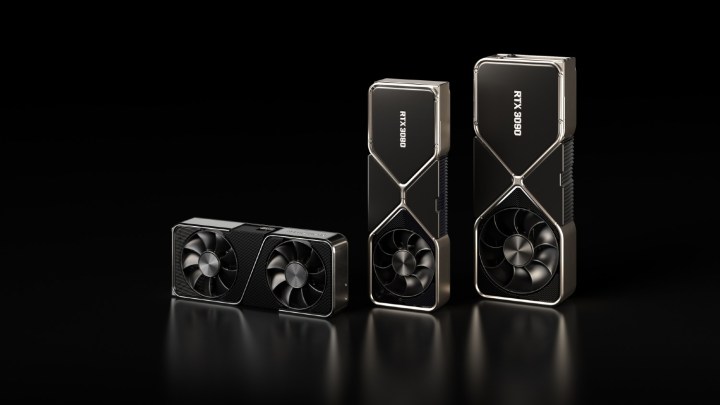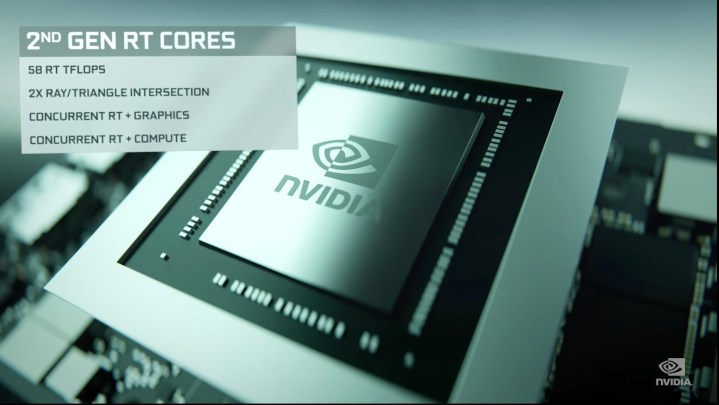Sales of Nvidia’s GeForce RTX 3090 have already begun (and sold out, of course). The company’s most powerful GPU, which bests the performance of the flagship RTX 3080, is proving to be a popular option for more than just enthusiast PC gamers. Creatives, data scientists, and those working in artificial intelligence are bound to find the unique tech in the RTX 3090 useful.
At $1,499, the RTX 3090 costs more than double the $699 RTX 3080. Although it certainly is Nvidia’s fastest gaming silicon right now, is Nvidia’s powerful GPU a splurge that gamers should take on? Here are the things that initial benchmarks, tests, and reviews are saying about the RTX 3090.
Design

Even though Nvidia is labelling the RTX 3080 its flagship second-generation raytracing GPU, the RTX 3090 is the most powerful card in its Ampere lineup. Befitting of its performance, the card comes in a beefier package that’s both longer and bigger than the RTX 3080, in Nvidia’s new metal-clad design with cooling fins and a new fan arrangement. Nvidia CEO Jensen Huang called the RTX 3090 its “BFGPU” (big, ferocious GPU) when the card was announced because of its robust triple-slot design.
As such, a few publications, including PC Gamer, were caught off guard by the sheer size of the card. The size means that your rig should be big enough to accommodate the card, if you’re striving for Nvidia’s best silicon, so compact desktops need not apply here. Even if you have a desktop with space to fit the BFGPU, you may not want to move your rig around too often to prevent the card from shifting around and ruining your PCIe slot.
If you’re looking at a multi-GPU setup, one thing to note is that the new fan design means that hot air gets blown back into your PC case rather than venting out with a traditional blower-style design. For a single-GPU setup, the fan design was very effective, PC World noted, drawing more than 500 watts and running at just 68 degrees under load.
Made for creatives

Even though Nvidia is marketing the RTX 3090 to gamers, the card is actually the successor to the Titan RTX, a Turing-based GPU that is part of Nvidia’s RTX 2000 series, that was geared toward professional use. Given the RTX 3090’s heritage, performance in creative workflow will be excellent, with the new card readily beating the Titan RTX by as much as 50% to more than 100% in a number of synthetic benchmarks.
As expected, the RTX 3090 performs well in a number of creative and professional benchmarks. Given that it’s already a more robust version of the RTX 3080 — with 24GB of RAM to boot — we can expect the 3090 to outperform the flagship. Now, we know that this card gets a 21% performance lead against the RTX 3080 in the SANDRA GPGPU test, according to PC Gamer, and it gains twice the performance uplift when compared to the Titan RTX and RTX 2080 Ti. That’s a massive leap and will be beneficial to professionals who rely on GPUs as tools for their workflows.
With its massive 24GB of fast GDDR6X memory, additional cores, and architectural change moving from Turing to Ampere, the GeForce RTX 3090 was an excellent performer in the Blender Rendering tests. Here, Hot Hardware noted that the card was three to four times faster than the RTX 3080 or Titan RTX. Performance of the RTX 3090 was significantly better than the Titan RTX in tests like OTOY Octane Render, OctaneBench, IndigoBench, and more. In Blender, TechRadar stated in its review that the RTX 3090 is up to twice as fast as the RTX 2080 Ti in rendering, thanks to how Ampere handles FP32 operations.

With OctaneBench, PC World found that the RTX 3090 delivered a whopping 86% better performance than the RTX 2080 Ti. The RTX 3090 also was 19% better than the RTX 3080 under this benchmark. The publication’s other tests showed that the RTX 3090 was the top performer in benchmarks such as SPECviewperf 13 and Puget System’s DaVinci Resolve Studio.
But when the GPU is taxed more heavily, the RTX 3090 really starts shining. Under heavy creative loads, the RTX 3090 appears to offer a considerable performance jump over its rivals, as seen on PCWorld’s test using the DaVinci Resolve Studio tests. With Open FX and Temporal Noise results, PCWorld noted that the RTX 3090 really starts outperforming its rivals.
For professionals, the performance uplift delivered by the RTX 3090 offers terrific value. With faster rendering, creatives could save a lot of valuable time in their workflow.
4K gaming

As expected, 4K gaming performance was excellent, though gamers who play at 4K resolution or under won’t find much of a significant uplift in performance when compared with the less expensive RTX 3080. When compared with the older RTX 2080 Ti, you’re getting up to a 30% boost in performance with Nvidia’s top-of-the-line graphics, but you’re paying a hefty premium here. Most gamers using an RTX 2000 series or older will likely be satisfied with saving the cash and upgrading to the RTX 3080 instead.
In Horizon Zero Dawn, you’re getting a 12% performance improvement, according to PCWorld, though the boost was just 5% when played at 1440p. This shows that unless you’re playing games that really stress the GPU, you won’t get much of a return on the RTX 3090 investment. The situation was similar with Gears Tactics, Metro Exodus, Borderlands 3, Strange Brigade, Total War: Troy, F1 2020, and Shadow of the Tomb Raider. In all these titles, PCWorld’s tests showed that the RTX 3090 was the top performing graphics card, delivering better framerates in both 4K and 1440p game play.
Given the cost of the card, though, you are still getting a diminishing marginal return compared to the RTX 3080 flagship.
HotHardware found that the RTX 3090 outperforms the RTX 3080 by just over 14% in Metro Exodus when using the Ultra quality preset in the game at 4K resolution. When compared to the Titan RTX, the RTX 3090 had a better minimum framerate, showing that you’ll get an improved gaming experience, and that the Ampere line will usher in
Given its strong hardware capabilities, the performance impact with ray tracing enabled isn’t quite as dramatic as with the RTX 2000 series cards. The RTX 3090 also performs better than the RTX 3080 at 4K resolution with ray tracing enabled, and you won’t notice as many frames dropped with the pricier card. In fact, the second-generation
The RTX 3090 still played at 72 fps (frames per second) with ray tracing turned on with DLSS, compared to just 63 fps on the RTX 3080 and 55 fps on the Titan RTX on Metro Exodus, according to Hot Hardware’s benchmarks. With raytracing, you’re still making a tradeoff in framerates for better visuals here, but performance is better overall. In general, the RTX 3090 performed 13% better than the RTX 3080 with RTX and DLSS enabled, Hot Hardware concluded.
Performance capable of 8K gaming

To get to 8K, the RTX 3090 uses A.I. to upscale graphics to 8K, resulting in crisper scenes by using DLSS Ultra Performance Mode. The new DLSS 2.1 specifications uses what Nvidia dubs 9x AI Super Resolution by using hardware to render images at 1440p and then upscaling those images to 8K mode.
Though the RTX 3090 delivers strong 4K gaming performance against its rivals in Nvidia’s family of graphics, performance at 8K was somewhat more mixed. While the RTX 3090 crushed the competition in some games, it barely outperformed the RTX 3080 in other titles.
One example of this is Middle Earth: Shadow of War. In this title, the RTX 3090 performed at 38 fps, compared to just 31 fps on the RTX 3080 and under 30 FPS for the Titan RTX. This means that the RTX 3090 performed 22% better than the RTX 3080. However, on Gears Tactics at 8K, the RTX 3090 performed at 22 fps compared to 21 fps and 19 fps on the RTX 3080 and Titan RTX, respectively.
It should be noted that many of the reviews out there have not tested game performance on an actual 8K monitor. Instead, most reviewers rely on Nvidia’s 4X Dynamic Super Resolution software to unlock the 8132 x 4320 resolution on a standard 4K screen. The result is that only a few games — GTA V and F1 2020 — played at or around Nvidia’s stated 60 fps promise in Ultra settings. Most games, however, played at around 30 fps in this setting, including Shadow of the Tomb Raider, Horizon Zero Dawn, and Gears Tactics, according to PCWorld’s testing. The publication noted that there is quite a bit of sluggishness, and artifacts could be present at the lower framerates.
Some titles tested, like Horizon Zero Dawn and Gears Tactics come with dynamic resolution scaling that offers better performance, but the tradeoff is blurriness, as the feature doesn’t use artificial intelligence or DLSS 2.0 to clean up the scenes. PCWorld warned that blurriness in those scenes can become very apparent.
A lot of gamers will likely not have to worry about blurriness — or even 8K gaming — at this point. Most gaming monitors, especially those that support Nvidia’s G Sync, top out at 4K resolutions while many mainstream gamers still play at 1080p or 1440p resolutions. Given that 8K panels are still targeted for professional workflows, existing monitors often come with slower refresh rates that make them less ideal for gaming, and the benefits of upscaling to 8K and then downscaling to a
It’s unclear if gamers will appreciate dynamic resolution scaling, or if more titles will build those in. Until we see 6K or 8K panels purpose-built for gaming with high refresh rates, faster response times, and minimal lag, then we won’t be able to truly exploit the benefits of Nvidia’s 8K game-ready GPU.
Conclusion

The RTX 3090 is a monster GPU befitting of its BFGPU moniker. According to these first-round reviews, its performance in gaming and professional benchmarks show that it has the chops to take on and beat all of its competitors hands down. Gamers upgrading from an older GPU generation will easily see the appeal of the RTX 3090, despite its sky-high price, but what you really should take a look at is the significantly more affordable RTX 3080. Given that the RTX 3090 costs more than double the RTX 3080 and delivers just 10% to 20% faster performance, gamers will likely be best served by skipping this card despite its powerful performance.
Unless you’re a gamer on the bleeding edge of technology who needs the best of everything, it will take some time for 8K gaming to become a reality without having to resort to upscaling tricks and for affordable 8K monitors to show up. You’re really not missing much by choosing the RTX 3080, even if it isn’t Nvidia’s best silicon. The RTX 3080 is the more sensible alternative given that it can readily handle 4K gaming at 60 fps today.
For creatives, the strong performance of the RTX 3090 makes it an easier to justify business expensive — the card can analyze data, render images and videos, and do things faster, making it a true time-saver. And when time is money, the initial outlay for the card can easily be recouped with a boost in productivity for business use.



